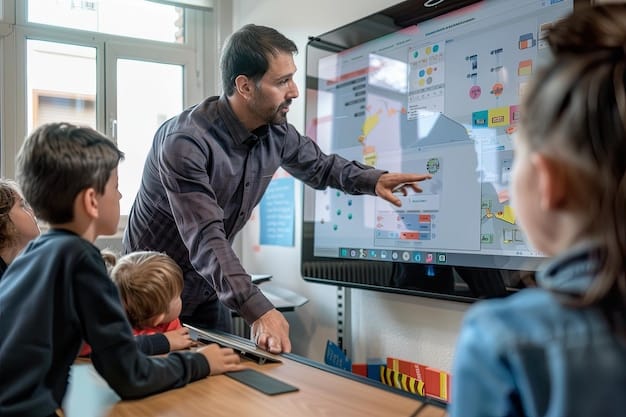AI-Driven Personalized Education: Reshaping US Schools by 2025

AI-driven personalized education is poised to transform US schools by 2025, offering tailored learning experiences, enhanced teacher support, and data-driven insights to improve student outcomes and address achievement gaps.
How Will AI-Driven Personalized Education Reshape US Schools by 2025?
The landscape of education in the United States is on the cusp of a significant transformation. By 2025, AI-driven personalized education is expected to be a major force, changing how students learn, how teachers teach, and how schools operate. What will these changes look like, and what impact will they have on the future of education?
The Rise of Personalized Learning
Personalized learning has been a buzzword in education for years, but AI is finally making it a realistic possibility on a large scale. This approach recognizes that every student learns at their own pace and in their own way, and it seeks to tailor instruction to meet individual needs.
What is AI-Driven Personalization?
AI algorithms can analyze vast amounts of data about student performance, learning styles, and preferences. This information can then be used to create customized learning paths, recommend specific resources, and provide targeted feedback.
Benefits of Personalized Learning Paths
Personalized learning paths allow students to focus on the areas where they need the most help, while also challenging them in areas where they excel. This can lead to increased engagement, better understanding, and improved outcomes.
- Provides customized content and pacing for each student.
- Adapts to individual learning styles and preferences.
- Offers immediate feedback and support.
- Tracks progress and identifies areas for improvement.
The shift towards personalized learning driven by AI holds immense promise for creating more effective and equitable educational experiences for all students.

AI as a Teacher’s Assistant
AI is not intended to replace teachers, but rather to augment their capabilities and free them up to focus on the most important aspects of their job: building relationships with students, providing individualized support, and fostering critical thinking skills.
Automating Administrative Tasks
AI can automate many of the time-consuming administrative tasks that teachers currently handle, such as grading papers, tracking attendance, and communicating with parents. This can free up valuable time for teachers to focus on instruction and student support.
Providing Data-Driven Insights
AI can also provide teachers with data-driven insights into student performance, helping them to identify students who are struggling and tailor their instruction accordingly. This can be especially helpful in large classes where it can be difficult to track the progress of every student.
By taking on administrative burdens and providing valuable data, AI can empower teachers to be more effective and responsive to the needs of their students.
Expanding Access to Education
One of the most exciting potential benefits of AI in education is its ability to expand access to high-quality learning opportunities for students in underserved communities. AI-powered tools can help to overcome barriers such as geographic isolation, lack of resources, and teacher shortages.
Breaking Down Geographical Barriers
Online learning platforms powered by AI can provide students in rural or remote areas with access to the same educational resources as their peers in urban areas. This can help to level the playing field and ensure that all students have the opportunity to succeed.
Addressing Teacher Shortages
AI tutors and virtual assistants can provide personalized support to students in schools that are facing teacher shortages. These tools can help to fill gaps in instruction and ensure that students receive the attention they need to thrive.
AI can significantly reduce the educational inequities between different communities in the US.
The Challenges of Implementation
While the potential benefits of AI in education are clear, there are also significant challenges to implementation. These include concerns about data privacy, algorithmic bias, and the need for adequate teacher training.
Addressing Data Privacy Concerns
AI-powered learning platforms collect vast amounts of data about student performance, learning styles, and preferences. It is essential to ensure that this data is protected and used responsibly, in accordance with privacy laws and ethical guidelines.
- Implement robust data security measures.
- Obtain informed consent from parents and students.
- Ensure transparency about data collection and usage practices.
Preventing Algorithmic Bias
AI algorithms are only as good as the data they are trained on. If the data reflects existing biases, the algorithms may perpetuate or even amplify those biases. It is crucial to ensure that AI algorithms are fair and equitable for all students, regardless of their race, ethnicity, gender, or socioeconomic status.
Investing in Teacher Training
Teachers need to be properly trained on how to use AI-powered tools effectively. This includes understanding how to interpret data, personalize instruction, and address potential biases. Without adequate training, teachers may not be able to fully leverage the potential of AI.
By addressing these challenges proactively, we can ensure that AI is used in a way that benefits all students and promotes equity in education.

The Ethical Considerations
As AI becomes more prevalent in education, it is important to consider the ethical implications. We need to ensure that AI is used in a way that promotes human values, such as fairness, equity, and respect for autonomy.
Ensuring Human Oversight
AI should not be used to make important decisions about students’ futures without human oversight. Teachers and counselors should always have the final say in decisions about placement, promotion, and graduation.
Promoting Critical Thinking Skills
AI should be used to foster critical thinking skills, not to replace them. Students need to be able to evaluate information critically, solve problems creatively, and make informed decisions.
Avoiding Over-Reliance on Technology
It is important to avoid over-reliance on technology and to remember that human interaction is still essential for learning and development. AI should be used to enhance human connection, not to replace it.
A focus on ethics is essential for AI to improve education.
Looking Ahead to 2025 and Beyond
By 2025, AI is likely to be a ubiquitous presence in US schools. The extent to which it transforms education for the better will depend on how well we address the challenges and ethical considerations outlined above. With careful planning and thoughtful implementation, AI has the potential to revolutionize education and create a brighter future for all students.
The Future of Learning Environments
We can anticipate more flexible and adaptive learning environments as AI becomes increasingly integrated. Classrooms may evolve into personalized learning hubs where technology and teacher guidance converge to cater to individual student needs.
The Role of Educators in an AI-Driven World
Educators will become facilitators, mentors, and guides in AI enriched classrooms. They will focus on cultivating essential soft skills, fostering creativity, and instilling a lifelong love of learning.
The role of parents in education will remain paramount. As learners’ needs evolve, guardians will actively participate in conversations about AI and personalized education.
| Key Aspect | Brief Description |
|---|---|
| 💡 Personalized Learning | AI tailors education to individual student needs and learning styles. |
| 👩🏫 Teacher Support | AI assists teachers by automating tasks and providing data driven insights. |
| 🌍 Expanded Access | AI extends education to underserved communities and remote areas. |
| 🔒 Ethical Considerations | Addressing bias, data privacy, and ensuring human oversight in AI. |
FAQ
▼
AI algorithms analyze student data to tailor content, pacing, and feedback, adapting to individual learning styles and knowledge gaps.
▼
AI is designed to assist, not replace, educators. It automates tasks, provides insights, and enables teachers to focus on personalized student interaction and support.
▼
Ethical concerns include data privacy, algorithmic bias, and the need for human oversight to ensure fairness and prevent over-reliance on technology.
▼
AI can provide remote access to quality educational resources, support understaffed schools with virtual assistants, and address teacher shortages in rural areas.
▼
Critical thinking, creativity, problem-solving, and adaptability will be crucial, as AI can handle routine tasks, emphasizing uniquely human abilities in the workforce.
Conclusion
As we approach 2025, the integration of AI in US schools promises to revolutionize education by offering personalized learning experiences and enhanced teacher support. While challenges such as data privacy and algorithmic bias must be addressed, the potential benefits of AI in expanding access to quality education are undeniable. By embracing AI thoughtfully and ethically, we can reshape the future of learning and empower students to thrive in an increasingly technological world.





